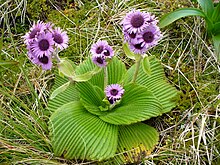
Damnamenia is a genus of flowering plants in the family Asteraceae.

Pleurophyllum is a genus of subantarctic plants in the tribe Astereae within the family Asteraceae.

Poa foliosa is a species of tussock grass commonly known as muttonbird poa. It is native to the subantarctic islands of New Zealand and Australia.

Leptinella plumosa is a small flowering plant in the daisy family. It is a circumantarctic species found on many subantarctic islands in the Southern Ocean. The specific epithet comes from the Latin for “feathery”, referring to the form of the leaves.

Chionochloa antarctica is a species of grass, endemic to the Auckland and Campbell Islands.

Anthoxanthum brunonis is a species of grass, native to the South Island of New Zealand and to the Auckland and Campbell Islands.
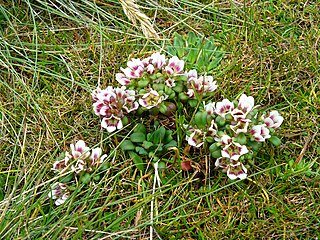
Gentianella concinna is a flowering plant species, endemic to the Auckland Islands of New Zealand.

The Flora Antarctica, or formally and correctly The Botany of the Antarctic Voyage of H.M. Discovery Ships Erebus and Terror in the years 1839–1843, under the Command of Captain Sir James Clark Ross, is a description of the many plants discovered on the Ross expedition, which visited islands off the coast of the Antarctic continent, with a summary of the expedition itself, written by the British botanist Joseph Dalton Hooker and published in parts between 1844 and 1859 by Reeve Brothers in London. Hooker sailed on HMS Erebus as assistant surgeon.

Ranunculus pinguis is a dark green, fleshy-leaved buttercup with relatively large, short-stalked flowers and narrow stiff yellow petals that grows in tufts. It is an endemic species of New Zealand on the Auckland and Campbell Islands that flowers from December to January and sets seeds between February and April.

The Botany of Lord Auckland's Group and Campbell's Island is a description of the plants discovered in those islands during the Ross expedition written by Joseph Dalton Hooker and published by Reeve Brothers in London between 1844 and 1845. Hooker sailed on HMS Erebus as assistant surgeon. It was the first in a series of four Floras in the Flora Antarctica, the others being the Botany of Fuegia, the Falklands, Kerguelen's Land, Etc. (1845–1847), the Flora Novae-Zelandiae (1851–1853), and the Flora Tasmaniae (1853–1859). They were "splendidly" illustrated by Walter Hood Fitch.

Myosotis antarctica is a species of flowering plant in the family Boraginaceae, native to mainland New Zealand, Campbell Island and southern Chile. Joseph Dalton Hooker described the species in his 19th century work Flora Antarctica. Plants of this species of forget-me-not are perennial with a prostrate habit, bracteate inflorescences, and white or blue corollas. It is one of two native species of Myosotis in the New Zealand subantarctic islands, the other being M. capitata, which also has blue corollas.

Abrotanella rosulata is a plant in the family Asteraceae, endemic to the Campbell Islands.

Myosotis capitata is a species of flowering plant in the family Boraginaceae, endemic to the Campbell and Auckland Islands of New Zealand. Joseph Dalton Hooker described the species in his 19th century work Flora Antarctica. Plants of this species of forget-me-not are perennial and erect, and have ebracteate inflorescences and blue corollas. It is one of two native species of Myosotis in the New Zealand subantarctic islands, the other being M. antarctica, which can also have blue corollas.

Marsippospermum gracile, common name - alpine rush, is a flowering plant species in the rush family Juncaceae which is native to New Zealand.
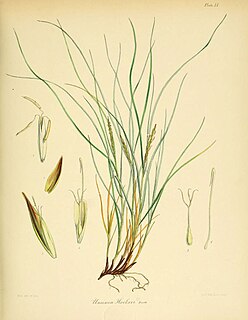
Carex erebus is a member of the sedge family and is found on the Antarctic Islands of Australia and New Zealand.

Agrostis subulata is a grass, which grows only on Campbell Island and on Antipodes Island in New Zealand.
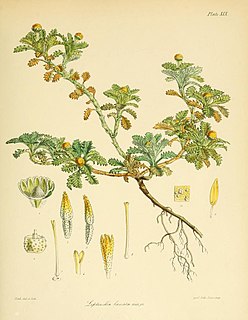
Leptinella lanata is a small flowering plant in the daisy family, native to the Antipodean Islands. Its specific epithet, lanata, describes its woolly-haired (lanate) rhizomes.
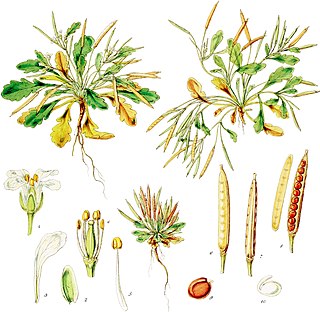
Cardamine depressa is a plant in the Brassicaceae family, found in the Antipodean Islands.

Megaherbs are a group of herbaceous wildflowers growing in the New Zealand subantarctic islands and on the other subantarctic islands. They are characterised by their great size, with huge leaves and very large and often unusually coloured flowers, which have evolved as an adaptation to the harsh weather conditions on the islands. They suffer from overgrazing due to introduced mammals.
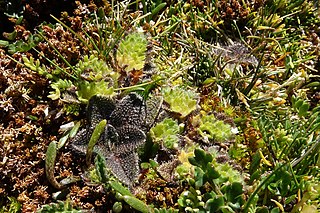
Myosotis antarcticasubsp. antarctica is a subspecies of flowering plant in the family Boraginaceae, native to New Zealand, Campbell Island, and southern Chile. Joseph Dalton Hooker described the species in his 19th century work Flora Antarctica. Plants of this subspecies of forget-me-not are perennial with a prostrate habit, bracteate inflorescences, and white or blue corollas. It is one of two native Myosotis in the New Zealand subantarctic islands, the other being M. capitata, which also has blue corollas.
